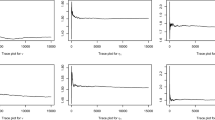Abstract
The structural recovery of amorphous glassy materials is nonlinear and nonexponential, and the relaxation process can be described by the phenomenological Tool–Narayanaswamy–Moynihan and Kovacs–Aklonis–Hutchinson–Ramos models. The nonlinearity parameter x in these models can be determined by several methods, including inflectional analysis, time–temperature superposition, and a new modified temperature-jump method, the latter a modification of the two-step Lagasse et al.’s method. The activation energy ∆h/R can also be determined by the first two methods. In this paper, the applicability of these methods for determining x and ∆h/R is analyzed using simulated structural recovery data as a function of aging time, after cooling at high rates such as those obtainable experimentally using Flash DSC. The results indicate that the activation energy obtained by the time–temperature superposition method is slightly better than that estimated by the inflectional analysis method. The results also indicate that the nonlinearity parameter x can be obtained by the inflectional analysis method for β = 1.0 and for low x and high β. On the other hand, the new modified temperature-jump method works for a broader range of x and β.







Similar content being viewed by others
References
McKenna GB. Glass formation and glassy behavior. Compr Polym Sci, Polym Prop. 1989;2:311–62.
McKenna GB, Simon SL. The glass transition: its measurement and underlying physics. In: Cheng SZD, editor. Handbook of thermal analysis and calorimetry. 3rd ed. 2002. pp. 49–109.
Tool AQ. Relation between inelastic deformability and thermal expansion of glass in its annealing range. J Am Ceram Soc. 1946;29(9):240–53.
Kovacs AJ. Glass transition in amorphous polymers: a phenomenological study. Adv Polym Sci. 1963;3:394–508.
Narayanaswamy O. A model of structural relaxation in glass. J Am Ceram Soc. 1971;54(10):491–8.
Moynihan CT, Macedo PB, Montrose CJ, Gupta PK, DeBolt MA, Dill JF, Dom BE, Drake PW, Easteal AJ, Elterman PB. Structural relaxation in vitreous materials*. Ann NY Acad Sci. 1976;279(1):15–35.
Hodge IM. Enthalpy relaxation and recovery in amorphous materials. J Non-Cryst Solids. 1994;169(3):211–66.
Kovacs AJ, Aklonis JJ, Hutchinson JM, Ramos AR. Isobaric volume and enthalpy recovery of glasses. II. A transparent multiparameter theory. J Polym Sci Polym Phys Ed. 1979;17(7):1097–162.
DeBolt MA, Easteal AJ, MACEDO PB, Moynihan CT. Analysis of structural relaxation in glass using rate heating data. J Am Ceram Soc. 1976;59(1–2):16–21.
Kohlrausch R. Theory of the electrical residue in the Leiden bottle. Pogg Ann Phys Chem. 1854;91:179–214.
Williams G, Watts DC. Non-symmetrical dielectric relaxation behaviour arising from a simple empirical decay function. Trans Faraday Soc. 1970;66:80–5.
O’Reilly JM, Hodge IM. Effect of heating rate on enthalpy recovery in polystyrene. J Non-Cryst Solids. 1991;131:451–6.
Hodge IM. Effects of annealing and prior history on enthalpy relaxation in glassy polymers. 4. Comparison of five polymers. Macromolecules. 1983;16(6):898–902.
Badrinarayanan P, Simon S, Lyng R, O’Reilly JM. Effect of structure on enthalpy relaxation of polycarbonate: experiments and modeling. Polymer. 2008;49(16):3554–60.
Hodge IM. Effects of annealing and prior history on enthalpy relaxation in glassy polymers. 6. Adam-Gibbs formulation of nonlinearity. Macromolecules. 1987;20(11):2897–908.
Hodge IM. Adam-Gibbs formulation of nonlinearity in glassy-state relaxations. Macromolecules. 1986;19(3):936–8.
Simon SL. Enthalpy recovery of poly(ether imide): experiment and model calculations incorporating thermal gradients. Macromolecules. 1997;30(14):4056–63.
DeBolt MA, Easteal AJ, Macedo PB, Moynihan CT. Analysis of structural relaxation in glass using rate heating data. J Am Ceram Soc. 1976;59(1–2):16–21.
Simon SL, McKenna GB. Interpretation of the dynamic heat capacity observed in glass-forming liquids. J Chem Phys. 1997;107(20):8678–85.
Hutchinson JM, Ruddy M. Thermal cycling of glasses. II. Experimental evaluation of the structure (or nonlinearity) parameter x. J Polym Sci, Part B Polym Phys. 1988;26(11):2341–66.
Zheng Y, Simon SL, McKenna GB. Modeling structural recovery in glasses: an analysis of the peak-shift method. J Polym Sci, Part B Polym Phys. 2002;40(18):2027–36.
Málek J. Rate-determining factors for structural relaxation in non-crystalline materials I. Stabilization period of isothermal volume relaxation. Thermochim Acta. 1998;313(2):181–90.
Echeverría I, Kolek PL, Plazek DJ, Simon SL. Enthalpy recovery, creep and creep–recovery measurements during physical aging of amorphous selenium. J Non-Cryst Solids. 2003;324(3):242–55.
Lagasse RR, Cohen RE, Letton A. Characterizing the kinetics of volume recovery in glasses by instantaneous temperature-jump experiments. J Polym Sci Polym Phys Ed. 1982;20(3):375–87.
Hutchinson JM, Kovacs AJ. On characterizing the pure temperature dependence of isobaric volume recovery in glasses. A critical evaluation of a method proposed by Lagasse, Cohen, and Letton. J Polym Sci Polym Phys Ed. 1983;21(11):2419–24.
Koh YP, Grassia L, Simon SL. Structural recovery of a single polystyrene thin film using nanocalorimetry to extend the aging time and temperature range. Thermochim Acta. 2015;603:135–41.
Schawe JEK, Pogatscher S. Material characterization by fast scanning calorimetry: practice and applications. In: Schick C, Mathot V, editors. Fast scanning calorimetry. Berlin: Springer; 2016. pp. 3–80.
Simon SL, Sobieski JW, Plazek DJ. Volume and enthalpy recovery of polystyrene. Polymer. 2001;42(6):2555–67.
Li Q, Simon SL. Enthalpy recovery of polymeric glasses: is the theoretical limiting liquid line reached? Polymer. 2006;47(13):4781–8.
Badrinarayanan P, Zheng W, Li Q, Simon SL. The glass transition temperature versus the fictive temperature. J Non-Cryst Solids. 2007;353(26):2603–12.
Koh YP, Simon SL. Enthalpy recovery of polystyrene: does a long-term aging plateau exist? Macromolecules. 2013;46(14):5815–21.
Greiner R, Schwarzl F. Thermal contraction and volume relaxation of amorphous polymers. Rheol Acta. 1984;23(4):378–95.
Koh YP, Gao S, Simon SL. Structural recovery of a single polystyrene thin film using Flash DSC at low aging temperatures. Polymer. 2016;96:182–7.
Ferry J. Viscoelasticity properties of polymers. New York: Wiley; 1980.
Acknowledgements
Support from the Whitacre Department Chair in Chemical Engineering is gratefully acknowledged.
Author information
Authors and Affiliations
Corresponding author
Rights and permissions
About this article
Cite this article
Bari, R., Simon, S.L. Determination of the nonlinearity and activation energy parameters in the TNM model of structural recovery. J Therm Anal Calorim 131, 317–324 (2018). https://doi.org/10.1007/s10973-017-6381-6
Received:
Accepted:
Published:
Issue Date:
DOI: https://doi.org/10.1007/s10973-017-6381-6




